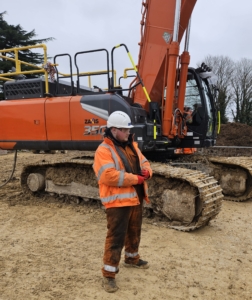Ground Stabilisation: Building on Solid Foundations with Deep Soil Mixing Ltd
In the world of construction, infrastructure, and land development, ground conditions are everything. Whether you’re working on a flood defence embankment, a road widening or new road scheme, or a brownfield redevelopment project, the ground must be stable, safe, and reliable.
This is where ground stabilisation becomes a critical part of the solution—and at Deep Soil Mixing Ltd, we’re proud to be leaders in the field, offering not only expert services but also free CPD-accredited seminars to share our knowledge with the industry.
What Is Ground Stabilisation?
Ground stabilisation refers to the process of improving the engineering properties of soil to make it more suitable for construction or long-term use. It typically involves increasing strength, reducing settlement, and enhancing bearing capacity—allowing the soil to support structures safely and efficiently.
Ground stabilisation is commonly required when working with:
- Soft clays, peats, or silts
- Poorly compacted fill
- Contaminated or variable ground conditions
- Flood-prone or waterlogged sites
Techniques Used in Ground Stabilisation
There are several techniques for stabilising ground, but one of the most effective, sustainable, and cost-efficient is soil mixing.
Deep Soil Mixing (DSM)
Deep Soil Mixing involves blending the in-situ soil with specially formulated binders to create a homogenous, solidified mass. This improves strength, stiffness, and durability—making it ideal for both geotechnical improvement and environmental remediation.
At Deep Soil Mixing Ltd, we offer soil mixing options to suit a wide range of site conditions and performance requirements.
Benefits of Ground Stabilisation with Soil Mixing
✅ Reduces Excavation – Minimal waste generation and no need for off-site disposal which with the recent increase in landfill tax is cost saving
✅ Improves Load-Bearing Capacity – Essential for supporting roads, embankments, buildings, and retaining walls
✅ Controls Groundwater – Helps reduce permeability and water ingress
✅ Cost-Effective – Faster than traditional piling and foundation methods
✅ Environmentally Friendly – Low carbon footprint and ideal for brownfield sites
Free CPD Seminars – Learn from the Experts
At Deep Soil Mixing Ltd, we’re passionate about sharing our expertise. That’s why we offer FREE CPDUK-accredited CPD seminars, designed to help engineers, consultants, developers, and local authorities understand ground stabilisation and soil mixing in more depth.
About Our CPD Seminars:
CPD UK-Accredited – Earn CPD points while expanding your knowledge
Flexible Format – Available in-person at your office or virtually
Comprehensive Content – Covers design, methodology, applications, case studies, and sustainability
Interactive Sessions – Ask questions, discuss projects, and gain practical insights
Whether you’re new to soil mixing or want a refresher on best practices, our seminars provide valuable knowledge tailored to real-world projects.
To book a free CPD seminar email us at stephanie@deepsoilmixing.co.uk
Why Choose Deep Soil Mixing Ltd?
Deep Soil Mixing Ltd delivers innovative, sustainable, and proven solutions across the UK.
We work across a wide range of sectors including:
- Transport infrastructure (roads, railways)
- Flood protection and coastal defences
- Brownfield regeneration
- Housing
- Reservoirs and canals
- Commercial and industrial developments
- Environmental/contaminated land remediation
- Slope stabilisation
Whether you’re planning a project or looking to boost your technical understanding, Deep Soil Mixing Ltd is here to help.
Call us: 01525 643562
Email us: info@deepsoilmixing.co.uk
Visit: www.deepsoilmixing.co.uk

 As Apprentice Plant Engineer, Seb Salt is based at the company’s Stafford plant yard. He splits his time between being on site and studying at Stafford College for an apprenticeship course in Land-Based Service Engineering.
As Apprentice Plant Engineer, Seb Salt is based at the company’s Stafford plant yard. He splits his time between being on site and studying at Stafford College for an apprenticeship course in Land-Based Service Engineering. Dalia Jaisan is an experienced civil engineer and is Deep Soil Mixing Ltd’s new Geotechnical Laboratory Technician. Based at the company’s head office in Bedfordshire, she carries out testing of site samples, collecting the soils from various construction sites to test back in the laboratory.
Dalia Jaisan is an experienced civil engineer and is Deep Soil Mixing Ltd’s new Geotechnical Laboratory Technician. Based at the company’s head office in Bedfordshire, she carries out testing of site samples, collecting the soils from various construction sites to test back in the laboratory. Based on site, Dean Hill is Assistant Project Manager and is working alongside Site Manager Ash Critchlow. His role involves handling all on-site paperwork, drawings and plans with the principal contractor, project managers and engineers to keep progress on schedule, and ensuring the work taking place at the site runs smoothly.
Based on site, Dean Hill is Assistant Project Manager and is working alongside Site Manager Ash Critchlow. His role involves handling all on-site paperwork, drawings and plans with the principal contractor, project managers and engineers to keep progress on schedule, and ensuring the work taking place at the site runs smoothly.

